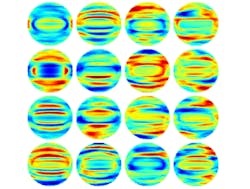| Seen here are representative major light scattering patterns of a single bacterium, from which its species (Lactobacillus casei) was identified from a machine-learning algorithm. (Credit: YoungJu Jo and YongKeun Park/KAIST) |
Researchers at the Korea Advanced Institute of Science and Technology (KAIST; Daejeon, South Korea) have developed a new way to exploit conventional optical microscopes for identifying bacteria. Based on Fourier-transform light scattering, the technique is not only label-free, but allows identification of a single bacterium.1 It is potentially important for the rapid identification of harmful pathogens that cause either human illness or the contamination of food.
The new approach involves bouncing laser light off individual bacteria under the microscope, using quantitative phase imaging (QPI) to create holographic images of them, and then using a software-based (machine learning) Fourier transform to analyze the images and identify them by comparing the Fourier-transform results to those from other, known bacteria.
Conversion of existing microscopes
"We have also developed a compact portable device, so called quantitative phase imaging unit (QPIU),2 to convert an simple existing microscope to a holographic one, in order to measure light scattering patterns of individual bacteria, which can then be used to identify bacteria species for rural areas and developing countries," says physicist YongKeun Park. "Our team has plans to go to Tanzania next month for a field test."
The existing gold standard in the health-care industry for making a definitive diagnosis involves culturing the microbes from a patient's blood in the lab -- a slow technique. Also routinely used today is a DNA-analysis technique called quantitative polymerase chain reaction (qPCR); this approach is faster, but can still take hours to produce a result (in addition, it requires expensive sample preparation that is often too expensive for routine use in rural or resource-poor settings around the world). The hours-long wait can be lethal in cases of sepsis or other fast-moving bacterial infections. As a result, many hospital-acquired infections are treated presumptively, before they are definitively identified, using broad-spectrum antibiotics. These powerful combinations of potent drugs are often effective, but using them routinely raises the risk of breeding deadly multidrug-resistant bacteria.
Accuracy of 94% or more
In their initial experiments, Park and his colleagues showed as a proof of principle that they could identify bacteria with high accuracy. They examined four different bacterial species (Listeria monocytogenes, Escherichia coli, Lactobacillus casei, and Bacillus subtilis). The first three are all pathogens known to infect humans through the food chain or via hospital-acquired infections. The fourth is a harmless bacteria used in laboratory research but of great interest because it is closely related to the deadly Bacillus anthracis, which causes anthrax.
Under a microscope, all four of these rod-like bacteria look nearly identical and would be virtually impossible to visually distinguish. The KAIST team, however, sorted them using the QPIU process with an accuracy greater than 94%.
The KAIST researchers are now looking to extend their initial work to see if they can distinguish between several types of bacterial subgroups -- to identify the most drug-resistant or virulent strains from the innocuous ones.
Source: The Optical Society (OSA)
REFERENCES:
1. YoungJu Jo et al., Optics Express (2015); doi: 10.1364/OE.23.015792
2. KyeoReh Lee and YongKeun Park, Optics Letters (2014); doi: 10.1364/OL.39.003630
This article was originally published on 6/8/2015
